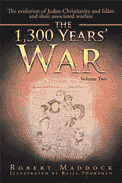
 |
The 1300 Years’ War, Volume Two: The Evolution of Judeo-Christianity and Islam and their Associated Warfare
by Robert Maddock
illustrated by Raija Pönkänen
Xlibris
This book is made up of various sections, each best enjoyed when read and considered at length. The largest section covers significant military events, starting in the 1600s with the first modern war and reliance on guns and powder. Called the 30 Years' War, it was fought in Europe and ended when warfare became too costly for princes to wage. Sub-sections document the active battles between the Ottoman Empire and Judeo-Christian nations through to the start of the twentieth century. The WWI peace treaty divided up most of the land that had once been part of the Ottoman Empire. Maddock attributes the downfall of that empire to financial issues.
The author touches upon the traditions of viziers, dynasties, sultans, and harems (covered in depth in Volume I). After Muslims by necessity adopted Western practices, modern-day Turkey resulted, with imams still in charge. The discovery of oil allowed the Arab leaders to increase their financial position. Persian oil production in partnership with westerners was at 5% of the world's oil supply in the early 1900s. By the 1980s, Saudi Arabia owned 100% of Aramco and monies were available to fund the rise of terrorism.
Maddock's talent for documenting history is not surprising due to his association with the military and academia, as well as Mormons, who are noted for genealogical research. He uses this background to compare and contrast handling of the Koran's original sources with the more recent process of publishing revelation received by Joseph Smith, founder of the Mormon religion. The author skillfully retells events, conspiracies, and important happenings of each time period. For complex stories, the third-person pronoun can make for confusion. But with charming illustrations by his wife, the people behind each story come alive. While it appears that Volume I is necessary to place this series in context, exhaustive lists, an epilogue, a timeline, and a reference section with perhaps too many Wikipedia sources help place the 1300 years’ war into historical context.
RECOMMENDED by the US REVIEW